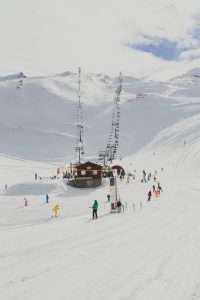
On Skiing: The Metaphysics by Stark
By Marilynn Stark

This metaphysics is drawn from the discipline of skiing and was written by me as an offering unto the Lord and unto the ski world. To me skiing is a yoga, a practice in the physical whose design and whose beauteous surround in nature work to synergize the realization of truth and of self in a learning mode of great worth. May I dedicate this Web page to Grandmaster Duk Sung Son, whose mastery in the martial arts as he taught me worked so vitally to teach me the fuller dimension of skiing.
Marilynn Stark
© 1997 by Marilynn Stark All Rights Reserved
तत्त्व हिमसंसर्पणम्
tattva himasaṁsarpaṇam
The Truth of Skiing
Verse 1
ओम् हिम हयस्वेत ब्रह्मने लोके तु नमस्ते।१।
om hima hayasveta brahmane loke tu namaste. |1|
Om Salutations unto Thee, the conveyance as white snow, which verily is the Supreme Spirit, Brahman, in this world. (1)
COMMENTARY
Tattva Himasaṁsarpaṇam begins with the invocation of the holy omkara. The next word, hima, which means snow, forms the subject of the sentence. Hima introduces the simple reality of ‘what is.’ The beautiful poetry of Sanskrit, which derives partly from sheer grammatical structure, matches the topic word, snow, with the concept that snow is to be regarded as a conveyance — hayasveta — literally, ‘white horse.’ Hayasveta stands grammatically as subjective complement to hima, thereby connoting ‘becoming’ or ‘fusing with’ that reality as a skier. That is why ‘horse’ or ‘haya‘ is used in stem form grammatically to combine with the obvious ‘whiteness’ of the ski world, sveta.
The word Brahmane comes next in the dative case, matching the salutation (namaste) at the end of the line so as to lend reverence. Loka in the locative case as loke, place where grammatically, focuses that absolute Brahman into the reality of this world powerfully, and by the synchrony of the “e” sounds of Brahmane and loke, the reverence is matched from the absolute realm down into the locale; this reverence as intimated through the sound “e” is now uttered once again as the actual word definitional of reverence, namaste, is placed at the end of the sloka.
Tu means ‘indeed,’ or more emphatically tu means ‘verily.’ Tu reasserts that sense which implies the almost contrariness of that fusion from absolute to locale to absolute.
Any skier knows the power of the snow whose bounteous gift of beauty is matched by the profound utility of the motion and navigability it provides for two skis. To address the snow in terms of reverence for the creation that is Brahman and to place the snow upon the metaphysical plane of reality as matched to the absolute should introduce the inquiry for the truth or tattva of skiing itself. The word tattva indicates the absolute truth since this word is comprised of tat + tva: the demonstrative pronoun tat meaning ‘that’ (referring to all that is in the objective world of inquiry) and tva meaning Thou, the inquirer. This word tattva therefore introduces through the fine resolve of Sanskrit as a language the concept of all of the universe being comprised of object plus subject: that plus Thou, or all of that plus you — the objective realm and the subjective inquirer are summed up in the single word ‘tattva.’ The title of the work on skiing is therefore opened with the word tattva which in turn opens the inquiry unto the nature of truth as is to be derived from himasaṁsarpaṇam, skiing, or snow gliding.
June 5, 2005 Edited March 15, 2010
Verse 2
भूम्यै गगनाय च समं ग समयेन स्थानेन च स्वाहा।२।
bhūmyai gaganāya ca samaṁ ga samayena sthānena ca svāhā |2|
Offerings unto the Earth and sky, going together through time and place. (2)
COMMENTARY
Offerings are rendered unto the Earth and sky which are manifestations of Brahman, the Supreme Spirit, previously invoked.
The instrumental case is used to indicate cause or reason (out of) for the invocation of time and space, samayena sthānena. Time and space are the only two fundamental continua which contain the physical worth of Earth and sky; thus these two continua, time and space, are rendered even unto the absolute nature of space as oblations. It is not that space is itself absolute, yet space inspires contemplations upon the absolute through its sheer, vast attribute of expansion that approaches infinity. The word sthānam (nominative case) can mean space or place.
To ski is to be enlivened greatly unto nature; therefore, nature becomes to the skier an entity to be further understood as an activity on the ground, the Earth, blessed by the expanse of space to be espied through the window of the giver of snow, the sky.
June 6, 2005 Revised and edited March 15, 2010 and April 5, 2010.
Verse 3
ॐ सरस्वत्यै नमः।
om sarasvatyai namaḥ.
Om. Salutations unto Goddess Sarasvati.
ॐ शक्त्यै स्वाहा।
om śaktyai svāhā.
Om. Offering unto Thee power.
ॐ बलाय स्वाहा।
om balāya svāhā.
Om. Offering unto Thee strength.
ॐ मापनाय स्वाहा।
om māpanāya svāhā.
Om. Offering unto Thee balance.
ॐ नियतत्वाय स्वाहा।
om niyatatvāya svāhā.
Om. Offering unto Thee precision.
ॐ रयाय स्वाहा।
om rayāya svāhā.
Om. Offering unto Thee speed.
ॐ पञ्चभूतेभ्य स्वाह॥३॥
om pañcabhūtebhya svāhā. ||3||
Om. Offering unto Thee the five elements. (3)
COMMENTARY

Sarasvati
Sarasvati, the goddess of learning, is now invoked in Tattva Himasaṁsarpaṇam. Any yoga, where yoga is defined as a discipline through which one binds to the Self, is a discipline of learning and knowledge. One surrenders the false ego, or the sense of the Self which is identified with the body, to Sarasvati; one can humble oneself therein to the teaching of Sarasvati most profoundly. This type of learning confers greater realization of the Self, and this self-realization will also include the objective realm with its knowledge base of factual truths. The factual truths of skiing can be explicated through practical knowledge and even through the laws of physics. Yet, the kind of knowledge which is also sought by a yogi, one who strives for greater self-realization, is that knowledge of the metaphysical under which is subsumed the physical laws of nature.
The most efficient ski techniques will be of the maximum economy of motion. In order to achieve such maximum economy of motion, the five elements of motion which should be used knowingly in physical action are enumerated and offered to Sarasvati. These five elements of motion are: power, strength, balance, precision and speed.
July 7 & 12, 2005
Verse 4
हिमसंसर्पणारित्रे चलेयं कालाकशे
himasamsarpāritre caleyaṁ kālākaśe
May I ski through time and space
स्वरैक्येनाशेषेन पञ्चभूतैश्चलनस्य
svaraikyenāśeṣena pañcabhūtaiścalanasya
in perfect harmony with the five elements of motion
शोभायां
śobhāyāṁ
in the splendor
स्वरूपस्य शैले हिमागमस्य॥४॥
svarūpasya śaile himāgamasya. ||4||
of nature on the mountain of winter.
May I ski through time and space in perfect harmony with the five elements of motion in the splendor of nature on the mountain of winter. (4)
Verse 5 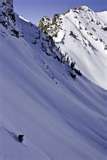
एवम् आकाशाद्भवं पञ्चभूतनिनि चलनस्य
evam ākāśādbhavaṁ pañcabhūtani calanasya
अशिषणि दातुं नित्यसातत्याय क्शराय
aśiṣaṇi dātuṁ nityasātatyāya kśarāya
कालाय कर्मसमुद्भवं इति।
kālāya karmasamudbhavaṁ iti.
तस्माद्ब्रह्मोद्भवं अक्षरात्कर्म यज्ञे॥५॥
tasmādbrahmodbhavaṁ akṣarātkarma yajñe.||5||
So the five elements of motion arise from space blessed with the continuum of the perishable, time; thus action arises, and therefore action arises from the imperishable Brahman through sacrifice. (5)
Verse 6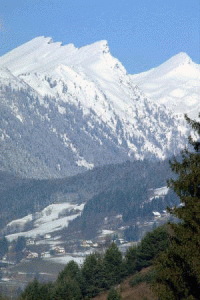
अहं वेद क्षरभवं हिमसंसर्पनाभ्यां अक्षरात्कर्म
ahaṁ veda kṣarabhavaṁ himasaṁsarpanābhyāṁ akṣarātkarma
यज्ञात्नित्यात्परं ब्रह्म॥६॥
yajñātnityātparaṁ brahma. ||6||
May I know the perishable as born of the imperishable through my skis and the action as born of sacrifice eternal that is limitless Brahman. (6)
Verse 7
हे शादि मं महाप्रमाणैकाग्रं जवं हिमसंसर्पणारित्रे मे पञ्चभूतचलनजम्।
he śādi māṁ mahāpramanaikāgraṁ javaṁ himasaṁsarpaṇāritre me pañcabhūtacalanajam.
Oh, teach me, my skis, great and closely attentive speed born of the five elements of motion
तथाप्यकैकेऽनुरूपतायां सत्यतायां सत्यभवं स्थानवर्णाकारेग्रे
स्थूललोकस्य॥७॥
tathāpyakaike’nurūpatāyāṁ satyatāyāṁ satyabhavaṁ sthānavarṇākāregre sthūlalokasya. ||7||
Oh, teach me, my skis, great and closely attentive speed born of the five elements of motion yet in one-to-one correspondence with the reality derived from satyam which is the topographical contour in the physical realm before me. (7)
Verse 8
विसृत्वरतरैकतात्वं ज्ञेयं शरीरेन
visṛtvarataraikatātvaṁ jñeyaṁ śarīrena
मनसात्मा च यथा चलेयं हिमं सुगिरौ।
manasātmā ca yathā caleyaṁ himaṁ sugirau.
सहचारहृदि भूमिगगनप्रकीर्तनकर्मवित्-
sahacārahṛdi bhūmigaganaprakīrtanakarmavit-
योग्यविवरनकृदाकारस्थाने॥८॥
yogyavivaranakṛdākārasthāne.||8||
May I know an ever more expanding unity of body, mind and spirit, so that I can know how to ski the snow in loving harmony with the mountain beautiful in the synergy of ground and sky in such technique accomplished as fitting to the topographical contour before me. (8)
Verse 9
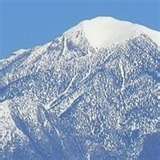
आश्च्सर्यं आकाशस्य दिव्यस्य विशालस्य च
āścsaryaṁ ākāśasya divyasya viśālasya ca
दृष्टिं शृङ्गशैलस्यैतस्यैव हि तेजस्विनः।
dṛṣṭiṁ śṛṅgaśailasyaitasyaiva hi tejasvinaḥ.
तोलेयं प्रवणस्थाने नित्योदज्भक्त्या
toleyaṁ pravaṇasthāne nityodajbhaktyā
पादसाधनपाणिदृढग्रहयष्टिवरदैश्वर॥९॥
pādasādhanapāṇidṛḍhagrahayaṣṭivaradaiśvara. ||9||
Indeed, may I match only through the Lord in the descent with an ever-ascending devotion the wonder of the vast and Heavenly space that is in the view of this glorious mountain peak. The Lord is the giver of the gift of the tools beneath my feet and the poles in the grip of my hands. (9)
Verse 10
आश्चर्यायेश्वरस्यैवं गते सृष्टेर्हैमंतयाः संपूर्णेन समार्पणेन तत्सत्याकुर्याम्।
āścaryāyeśvarasyaivaṁ gate sṛṣṭerhaimaṁtayāḥ saṁpūrṇena samārpaṇena tatsatyākuryām.
May I realize in full surrender to the wonder of God’s wintry creation and in these (prevailing ) conditions
अतिसूक्ष्माद्भूतहिमसंसर्पणारित्रचलने
atisūkṣmādbhūtahimasaṁsarpaṇāritracalane
in miraculous, yea, subtle motion on skis that: (that = tat, above: ‘tatsatyākuryām’ = may I realize that)
संपन्नतांस्वभावजां एवमेव नु।
saṁpannatāṁ svabhāvajāṁ evameva nu.
the perfection innate, yea, indeed,
आत्मानं आनन्दं येषां मनानि जाताकाशेन
ātmānaṁ ānandaṁ yeṣāṁ manāni jātākāśena
(which is) the self, the total bliss which is the Self, whose reflections are inspired by the space
दीननी मे हे आदौवुदयोत्तंगशैल।
dīnanī me he ādauvudayottaṁgaśaila.
at my humble command — oh, first for the ascent of the towering mountain
यस्य रक्षितृशृङ्ग जीवति परिषदि परस्य च धर्मस्य कालस्य अनान्तकाले तु॥१०॥
yasya rakṣitṛśṛṅga jīvati pariṣadi parasya ca dharmasya kālasya anāntakāle tu. ||10||
whose guardian peak lives in the assembly of the Supreme Self and the soulful nature of time, timelessness. 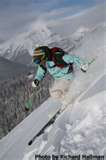 (10)
(10)
May I realize in full surrender to the wonder of God’s wintry creation and in these (prevailing ) conditions in miraculous, yea, subtle motion on skis that: the total bliss which is the Self, the innate perfection which is indeed the Self, whose reflections are inspired by the space at my humble command; oh, first for the ascent of the towering mountain, whose guardian peak lives in the assembly of the Supreme Spirit and the soulful nature of time, timelessness. (10)
Verse 11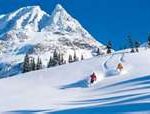
तथैव गुरुत्वं शादेद्मां कथं पाणिपादसमानी यथैव
tathaiva gurutvaṁ śādedmāṁ kathaṁ pāṇipādasamānī yathaiva
हिमरित्रसंसर्पनेयं।
himaritrasaṁsarpaneyaṁ.
यथैव स्वरैक्यंज संपन्नतायाः
yathaiva svaraikyaṁja saṁpannatāyāḥ
पञ्चभूतचलनस्योत्पतेत्लाभयंत्रं परिवृत्त्याः॥
pañcabhūtacalanasyotpatetlābhayaṁtraṁ parivṛttyāḥ.
यत्सत्यं परिवृत्तिं कार्यक्षमतायाः गुरिष्ठायाः पुन नेत्रे
yatsatyaṁ parivṛttiṁ kāryakṣamatāyāḥ guriṣṭhāyāḥ puna netre
आकारगंदस्य प्रत्यक्षम्।
ākāragaṁdasya pratyakṣam.
एवं जवेन कालं जयेयं।
evaṁ javena kālaṁ jayeyaṁ.
ततस्त्योत्संगधरणं एकैकशधर्मेन कृत्स्नं जानीयाम्।॥
tatastyotsaṁgadharaṇaṁ ekaikaśadharmena kṛtsnaṁ jānīyām.
यतः शैल पारे सर्वं सत्कृत्परमेश्वरेन यद्वद्नाकं
yataḥ śaila pāre sarvaṁ satkṛtparameśvarena yadvadnākaṁ
मेघेस्वेवनाकं करे शून्ये॥११॥
meghesvevanākaṁ kare śūnye.||11||
